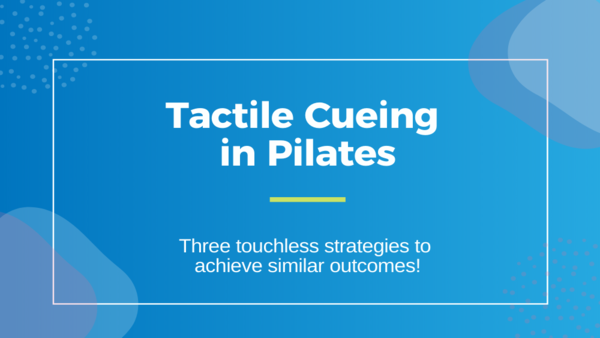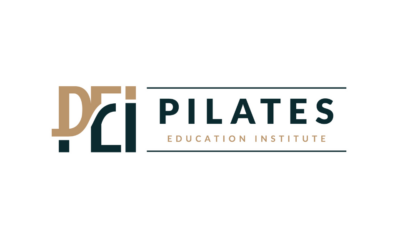November 10, 2020
Author: Suzy Levi, NCPT
The word “tactile” is defined as experiences or sensations received or felt by touch. In my opinion, using tactile cueing is one of the most powerful teaching tools in Pilates. When I am practicing Pilates, a tactile cue always help me understand where my body is in space, and the touch from the teacher helps connects me to the movement. As a teacher, I use tactile cueing daily with most of my students to help them find the best alignment possible and get the most out of the exercise.
If you would have asked me pre- pandemic, I would have told you that I could not practice or teach Pilates without tactile cues. Fast forward to present day, where virtual teaching and social distancing are here to stay, I knew it was important to not lose this technique and didn’t want to go without tactile cueing in my teacher’s toolbox. I adapted quickly and developed ways I could achieve similar results without touching and maintaining a safe distance from my students.
I would like to share helpful strategies I use daily to help connect my students to the movement and achieve similar results to tactile cueing.
Proprioception is simply defined as “knowledge of where your body is in space”. Our five senses help us navigate our external environment, and proprioception has been referred to by some as our “sixth sense”. Using tactile cues increases proprioception and improves your student’s awareness of their actual body position. Here are a couple of ways to increase proprioception without touching the student, and achieve results similar to touching:
- Take pictures and videos of your student performing the exercise to provide visual feedback and help them make adjustments. The great thing about this is you can do this in a virtual or in-person session. It is a great tool as they can refer back to it in their personal practice.
- Use mirrors to provide visual feedback. By looking in the mirror, your student is able to see their body position, connect to how it feels when they are in an incorrect alignment, and to then actively correct it themselves. This is key in aiding with muscle memory. This option is easy to implement in the studio or at home, as most students already have a mirror in their home.
Using props, instead of your hands or body to make corrections, provides feedback for the student similar to the feeling of tactile cues. Props can help students understand how to position their body correctly and give them direction to perform proper technique by providing a proprioceptive effect. Some of my preferred ways to utilize props:
- Gondola Pole or Short Box Dowel. Instead of using your hands, you can place the pole or dowel in the spot where they need to make an adjustment. For example, place it under their rib cage on Elephant to encourage the lift and scoop; or place it in a spot you want them to reach their feet towards. For example, Legs in Straps or Arabesque on the Reformer, and legs springs on the Cadillac. Think about how you usually tactile cue and the ideas on how to use the pole or dowel will flow freely to you. These are great tools for in-studio sessions and are perfect for maintaining social distance.
- Provide physical feedback by adding small equipment such as balls, yoga blocks, rollers and rings to the exercises. Using one of these props can increase awareness of body positioning and help your student maintain proper alignment. This is an easy option that works virtually or in-studio.
- Use a wall or a couch for exercises that require your student to reach for support and to find length. This helps provide feedback while stacking the spine up, pressing the back of the hips into it for stability while doing twisting exercises, (such as Saw or Spine twist,) and for exercises you reach through the heels to find length (like Roll up, Single Leg Circle, Rollover, and Neck Pull). Both the wall and couch provide physical feedback similar to tactile cueing and they are easily accessible at home or in-studio.
A “hands on” cueing approach helps our body feel where it is positioned and how to make adjustments to correct our alignment. As long as a person can understand where and how they need to move to improve the outcome of the exercise, it doesn’t matter if it is the teacher’s or the student’s hands, the result will be the same. Here are a couple manual cues I regularly use with my students:
- Cue them to place their hands on their pelvis when doing exercises that require pelvic stability. This gives them immediate feedback and helps them improve their ability to keep their pelvis still while moving other parts of their body.
- Direct them to use their hands for pelvic positioning. Often times we are not self-aware if our pelvis is crooked or out of place. Coaching students to use their hands to feel the space between their lowest rib and top of the hip on each side, or the space between their back and the mat, will help them understand when they need to make adjustments.
- Hands on the ribcage while twisting will help them keep the ribcage level and connected while performing exercises that require twisting. It also helps with understanding their own breathing.
These versatile tools can be easily added to your teacher’s toolbox and will provide additional awareness of body positioning for your students, improving their connection with their own bodies. Hopefully tactile cueing will return someday, but for now, these strategies do the trick!
Not yet a member of your professional association? Learn more on how to become one.
Interested in contributing to our blog? Contact Us to learn how you can be featured!



